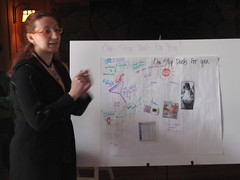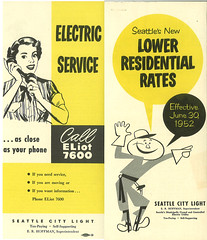
by jeanine&preston
I've learned these lessons while preparing for an upcoming offsite meeting for the leadership of my client, I'll be presenting on the trends that are going to impact them over the next few years.
- Create an agenda upfront so expectations are clear - This seems like commonsense that everyone would follow, but they don't. This is important so the attendees know what to expect, and so the presenters know what is expected of them. And please, let me know how long I have to speak, it makes a huge difference. Recently I held a meeting where I distributed an agenda ahead of time, but two of the key attendees never read the agenda and hijacked the meeting. It took me 10 minutes to get us back on track.
- Overcommunicate the time/s and location/s - I learned this lesson from the near weekly softball games I and my wife help orchestrate for a team, and no matter what we do a quarter of the people have to email/call at the last moment to find out where they need to be. This not acceptable in a business setting, so remind them a few times. Go so far as to leave a post-it note on their desk two days beforehand if need be.
- Define and review the next steps - Next stends are the post meeting's agenda, what the group has agreed to do next. If there are no next steps, then the meeting was not useful. Even if you are just "getting people on the same page" you should be able to clearly state who is going to do what next to move forward. Verbalize this as the final thing said at the meeting. Distribute this via email (or better yet a centralized task management system like Remember the Milk).
- Prepare them for the pitch - If there is any chance anything "salesy" will be presented, you need to make sure people are ready for it. This is quadruply important if you are a consultant putting your client in front of a pitch, forewarn them. And if you feel the sales pitch is too aggressive, end it.
- To read ahead or not read ahead - Read ahead material can be very helpful, especially if you need the audience to have a lot of facts and figures at their fingertips. If you present too much data without any background, they'll forget it (which can be ok if the data is merely a means to convey a specific point). If you provide read ahead material, and it is totally necessary for people to reach an educated decision, then make the expectation clear. You can even say that there will be a roundtable quiz to start off the session. Nothing like public shame to get your desired response.
- Kick the tires - If you are using another facility or space, physically go there and test it out the day beforehand (or that morning if you are doing an afternoon session). Make sure the computer and projector work, make sure the slides and videos work on that system. Make sure the temperature is acceptable. Know where restrooms are, etc.
- Decide how you will handle interruptions - Something is going to happen, whether it be the computer crashing or someone taking you off course for 45 minutes. Decide how you will handle this, give some up front planning to these things. You can't plan for them all, but you can prepare in general.
- Have a team huddle - If you are doing this with anyone else, make sure you are all on the same page.
I've screwed up several of these over the past 8 years, and it seems you have to re-learn these lessons every so often as well. Having a mindful and repeatible process for running a session greatly reduces your risk of screw up.
And if you are planning on the majority of the session to be done via Powerpoint, just know ahead of time you are fighting an uphill battle.
 Image by
Image by 
 I can no long search and find other calendards to incorporate into mine via Google Calendar.
I can no long search and find other calendards to incorporate into mine via Google Calendar. 